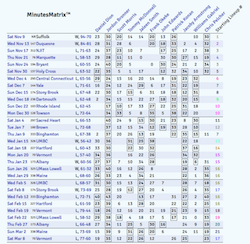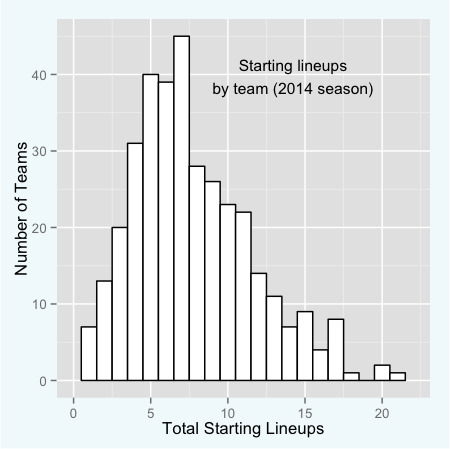The MinutesMatrixTM posted on the expanded player page can tell a story about a team over the season. Some programs are blessed with good health and overall stability while others suffer through injuries, suspensions, transfers, and unsteady play which requires the coach to constantly reevaluate how he doles out playing time. In looking over some of this data, it is striking how rare it is for a team to stick with one starting lineup through the entire season.
According to my information, a total of seven teams made it through last season with just one starting lineup: Cincinnati, Oklahoma, Providence, Sam Houston State, Stephen F. Austin, Utah Valley, and Wisconsin. Collectively, these teams went 93-31 in conference play which is part of the equation for lineup for lineup stability.

On the other end of the spectrum, New Hampshire somehow rolled out 21 different lineups in its 30 games. Amazingly, combo guard Jordon Bronner started every game, so the 21 combinations were confined to the other four positions, and those involved ten different players. UNH went 6-24, so you can understand why head coach Bill Herrion felt the need to try something different on a frequent basis. Herrion’s trotted out nine different lineups this season despite a more successful campaign by the Wildcats. They’re 10-9, 3-3 in America East and that first-ever tourney bid could be coming.
Coming in a close second was Seton Hall, who cranked out 20 different lineups, which included a different lineup in each of the Pirates’ first nine games. In addition to trying to find the right combination, head coach Kevin Willard had to deal with a host of injuries. One other impediment to lineup stability is the senior day tradition popular in the college cage game and that accounted for an additional Seton Hall lineup. Kevin Lynch got the start on March 3rd after getting six minutes the entire season to that point. (And Kevin Lynch owes me something for working him into this article.)
Here’s a histogram showing the number of starting lineups for each D-I team last season.

The median is seven, so don’t get all hysterical when your coach experiments with the starting lineup a few times. Practically everybody does it.
This season, Chicago State and Mississippi Valley State are the early leaders for most lineups with 14 apiece. Tracy Dildy has given 17 (!) players significant minutes in at least one game, so he has a lot of options to work with. In fact, starting doesn’t mean much for Chicago State. The Cougars have had seven cases of a starter player single-digit minutes. The Delta Devils started their 14th lineup Monday night against Southern. The two teams are a combined 6-21.
There are 17 coaches that haven’t wavered from their opening night starting lineup. Most of these schools have had successful seasons so there has been no need to revisit who’s starting. But not every one of these programs is winning. Phil Martelli has rolled out the same lineup for each of Saint Joseph’s 16 games, despite starting 7-9, and 1-4 in the Atlantic 10.
But my favorite case is at Idaho State, where if you win a starting job out of the preseason, you are a starter for the rest of the year. The Bengals are 4-14 and 1-5 in the Big Sky but the starting lineup has remained the same. Last season, in a year where Idaho State went 11-18 and 8-12 in conference, Bill Evans used the same lineup for 27 of the team’s 29 games. Either he’s very loyal, or more likely, he just doesn’t have other options.
Of course, this entire discussion ignores the fact that the starting lineup is partly a ceremonial distinction. It really matters who is playing in those key moments when the game is on the line. But you don’t get introduced at the beginning of the game unless you’re a starter. For very few teams, the script for those introductions doesn’t change all season.

